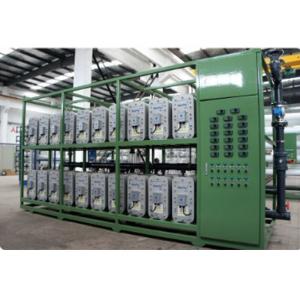

Add to Cart
cEDI Electro-Deionization to remove irons from water for food beverage | semi conductor 5m3/hour 18MΩ.cm
Specifications
Feed water datas
| Type | Unit | Allowed range | Best condition |
| PH | 5-9 | 7-7.5 | |
| Conductivity | µs/cm | <50 | <20 |
| Total Harness (CaCO3) | ppm | <1.0 | <0.5 |
| CO2 | ppm | <5 | <2 |
| SiO2 | ppm | <0.5 | <0.2 |
| TOC | ppm | <0.5 | no |
| Heavy ions (Fe, Mn, etc) | ppm | <0.01 | no |
| SDI | <0.5 | <0.2 | |
| Free Cl | ppm | <0.05 | no |
| Temperature | ℃ | 5-42 | 10-35 |
Features
Descriptions
Electro-Deionization, or EDI, is a process that evolved from conventional ion exchange technology. EDI provides continuousdemineralization at recovery rates of 90% or more. In EDI, just as in conventional ion exchange, cations and anions in the feedwater are exchanged for hydrogen and hydroxyl ions in the ion exchange resins, producing demineralized water. The key operational difference is that with EDI, the ion exchange resin is regenerated continuously, while withconventional ion exchange, chemical regeneration is performed intermittently. Continuous regeneration in EDI is achieved electrochemically, by means of ion conducting membranes and an imposed electric current. The hydrogen and hydroxyl ions necessary for regeneration are formed in-situ, without addition of chemical reagents, by means of the familiar water dissociation reaction, sometimes called water splitting.
Applications:
Factory test:
Competitive advantage
EDI product quality approaches 18 Mohm/cm resistivity at design conditions. The product quality is not sensitive to inlet feed fluctuations or spikes, nor does it decay over time as in the exhaustion of traditional deionization units. Reduction of both SiO2 and ionizable TOC in an EDI system is comparable to results achieved with primary mixed-bed operation.
